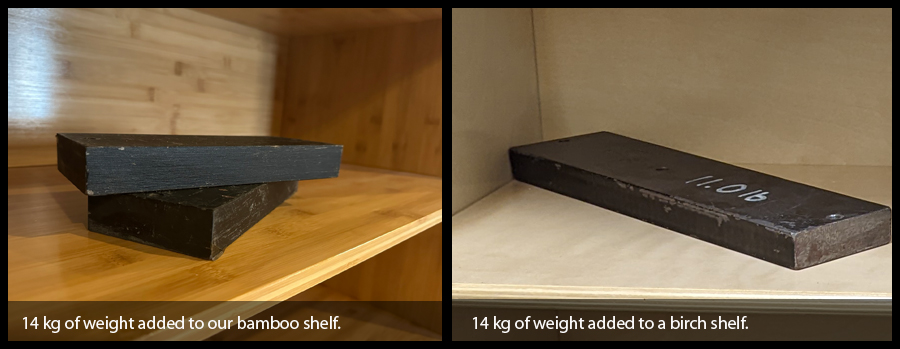OK, bamboo is strong. But – is it as tough as traditional wood typically used for classroom furniture? We put it to the test in our Product Testing Lab. We conducted four tests: load, humidity, impact, and surface cleaner.
Load Tests
Our Bamboo Shelving Units are used for classroom materials of all kinds. We added 14 kg of weight per shelf to our bamboo shelf and a different design made of birch. 14 kg is roughly equivalent to a baby panda! After 72 hours, neither shelf showed a deflection rate (warping) of more than 5mm. In fact, our bamboo performed better – it deflected 2mm less than the birch equivalent. Our bamboo shelf was even stronger than the wooden shelf.

Humidity Tests
Withstanding humidity is important. Parts of the world are extremely humid environments, and in lots of regions, schools don’t have the benefit of air conditioners. For this test, we loaded 9 tubs with 5 kg weight each and placed them on our Bamboo Book Browser Cart and a cart made of birch in an air-tight room with a humidifier filled with water. Once the room had reached a humidity level of 75%, we observed the effects on the carts. They spent the day at the spa if you will! We measured the deflection rate, defined as the “sag” or movement of bamboo from a straight edge when it is exposed to something like moisture in the air. After 7 days of testing, both carts' deflection rates stayed within the expected range. In other words, they passed the humidity test!
 Impact Tests
Impact Tests
Bamboo faced off with birch once again! We tested the edge, the middle, and a corner of a sheet of each material by dropping a 1.5 kg weight from a height of 29 1/2” (75cm). This test was repeated 5 times. Our conclusion here is that upon the impact of a heavy weight from a considerable height, the bamboo performed just as well as the birch. Although marking took place, the damage was superficial and didn’t affect the integral structure of the bamboo. It did not sustain any more damage than the birch. Let’s hear it for bamboo!
.jpg) Surface Cleaner Tests
Surface Cleaner Tests
This was a test to see how common cleaning solutions affected the finish of bamboo and birch. Lacquers are a popular finish type for furniture and the preferred choice of professional furniture makers. On our bamboo products, we use a nitrocellulose lacquer. We tested water, a 10:1 water and bleach solution, and a disinfectant. Water with blue food coloring was also used, to mimic marker or paint. The 3 cleaners were left on the surface for different periods of time and tested: 10 minutes, 5 hours, and 5 days. After the cleaning solutions were removed, both the bamboo and birch were subjected to a stain test with the blue dye to see if their surface finish was damaged by the cleaners. We discovered that both the bamboo and the birch reacted similarly to the cleaning solutions before and after the dye. In fact, there was more staining on the surface of the birch, so our conclusion is that the bamboo was more stain resistant.
.jpg)
We designed our first bamboo easel 10 years ago, the Double Sided Bamboo Teaching Easel. 
Aside from developing products that have less environmental impact, we also have to be sure they are the strong, durable classroom solutions our customers have come to expect from Copernicus. Nothing less will do.
Any bamboo parts or products we make are designed to hold the same or more weight than a comparable wood or steel product. Because working with bamboo is different, sometimes we have to design parts a bit differently to ensure that they are as strong. For example, on our Book Browser carts, the stretchers are a larger size of bamboo, to support the same amount of weight that the steel model does. We test all of our designs, regardless of the material, to ensure that they can stand up to rigorous classroom use, and will be durable for many years.
Given what we have learned and knowing that it would still be durable and long-lasting, but also kinder to the environment, bamboo is an obvious choice to continue to use for more of our products.
Explore our line of bamboo products.
 Skip to Content
Skip to Content